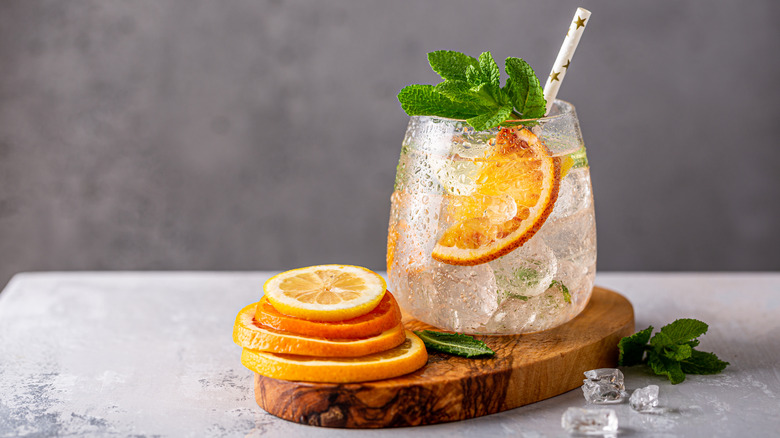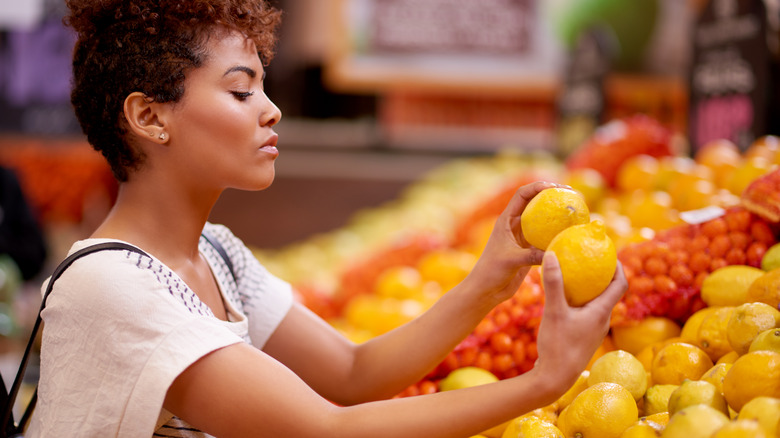How To Spot The Best Citrus For Your Perfect Cocktail Garnish
In a nutshell, there are two main types of cocktail garnishes that you need to know: functional and decorative. One of the most popular functional garnishes is citrus, which can add a burst of freshness and flavor to the drinks they're added to, and in some cases, the right citrus makes the entire drink. After all, how could you make a mojito without the lime?
For those occasions when you decide to go all out making some really classy cocktails, a lot of effort goes into choosing the right liquors. But what about choosing citrus fruits for the garnishes? To help us with these decisions, we contacted Cody Goldstein, mixologist and founder of the hospitality company Muddling Memories. He told us that the garnish for cocktails is a huge deal, explaining, "Nothing makes me more turned off at an establishment when they can not be bothered to at least cut a fresh citrus for a drink I am paying good money for."
And it makes sense, doesn't it? The same thing applies to the cocktails you're making at home: Why would you go through the effort of garnishing a drink in the first place, only to ruin it with something less than perfect? The good news is that Goldstein gave us some tips for choosing the perfect citrus, and it's about much more than just looks.
The right garnish starts with making smart choices at the store
When picking which oranges, lemons, limes, or grapefruits you'll use to take your cocktail to the next level, it makes sense to look for fruits without brown spots or blemishes. But there's more to choosing the perfect fruits. Cody Goldstein says he only picks fruits that have a shine.
"When it has some shine to it I know the essence oils are present and will give the citrus a much brighter flavor and aroma," he explained. "Another important factor," Goldstein added, "is the firmness of a citrus. You should be able to roll it on a table and feel a little give to ensure the citrus has juice inside and has not dried out." This is something to keep in mind when choosing your fruit at the supermarket.
The key to this is not to push too hard, which is also a great way to check for no overly soft spots or bruises. With a little practice, you'll also be able to pick the fruits that are heavier than they seem. That, too, is a sign your citrus fruit will be incredibly juicy, which, in turn, means more flavor.
Slightly overripe fruits still have their uses
We've all made plans for a cocktail night only to find the days getting away and the fruit we've picked is now slightly past its prime. While you can certainly still use overripe fruit to whip up some jam, Cody Goldstein says he prefers to still use that slightly overripe citrus for a cocktails.
Although he says that firmer, more perfectly ripe citrus is better for garnishes because it holds its shape better and has a stronger, brighter flavor, "For citrus that might be a bit past its prime, it is best to use for juicing or squeezing and discarding the skin as the peels may lack the fragrance and useful oils as they have mostly dried up."
And that's great news. Not only does it prevent you from wasting that fruit, but let's be honest here: We all know that classic sparkling paloma cocktail is even better with an extra squeeze of fresh grapefruit juice, right? Goldstein also recommends keeping an eye on your citrus and dehydrating it — which you can do right in your oven — before it goes bad. "This will allow you to use the citrus as a garnish that will be shelf stable and can be kept for a long while." And as a bonus, dried citrus can be used to garnish more than just cocktails. Use it to make your own tea blend, and it also adds a touch of elegance to cakes, salads, and ice cream.


